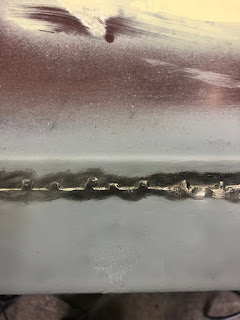It's Easter. Christians all over the world celebrate the return of Jesus from the dead and I guess there's me, celebrating another resurrection of the old Dre-XT-Stück. If my notes are correct this is the 5th time I am rebuilding this engine and the 4th time because of some sort of terrible engine disaster.
On today's menu:
A properly f*cked up piston
... and a crank with both dead big end
... and small end.
Impressive, eh? So how did THAT happen? Guess there's a reason they didn't build them with high compresison (10.5:1) 635cc engines from the factory, because some stupid 200 pound Gorilla (even technically I am more of an Orang-Utan) behind the bars will try to break the ton like it was meant to be. Throw in a bit of wet mist on the front and a large tank shielding the back of the cylinder from cooling air and a very spot on jetting and you have a beautiful recipe for destruction. May I point out though, judging by other cars speedos we were doing a healthy 150+ kph sitting up right and with the panniers installed. Old 'Stück had some proper get up 'n' go.
As hoarder has this terribly negative connotation, I will rather call myself curator of parts of questionable usability. BUT this time it has saved my bacon again. We have: one crank with a slightly knackered alternator-side taper and lots of glittery metal coming out, when being flushed with oil.
Turns out, not only are red oil-cans faster, but when filled with fresh and
clean oil and not whatever was too slow to run away, the crankshaft will
eventually no longer spit out oil laced with the remnants from other dead
engine. (Also meaning I should really clean out that other oil-can at
some point!)
Disassembly was sort of the usual, just a few highlights (you saw the outcome already):
Cam and rockers all good and plenty of oil up there (meaning that the engine
didn't die from oil-starvation).
Cam-chain tensioner still tensioning.
Combustion chamber shows no signs of "performance flying around in the
chamber", i.e. imprings of metal bits.
The piston-top is the living proof that even with a completely seized oil-scraper after maybe 20km of riding you won't be able to see much on the piston or on the cylinder wall.
As you've already seen what Petey the piston and Charlie the conrod looked like, just a few more selected pictures from tearing down the engine to get to the crank. The rotor put up the usual "good" fight.
As did one of the mangled allen head crank case bolts - that's why you should have at least ONE good vise grip.
Once all the bolts are out, the whole splitting the cases thing is pretty
straightforward. A few things to note: 1) no need to take the oil-pump out and
there's tabs on the front and back of the engine and with a wide flatbladed
screwdriver you can break the seal rather easily.
2) Prop up the cases on some wood and the whole crank-swapping malarkey is easy-peasy.
(If you really want to see more on taking the whole lot apart/reassembly, have
a look at one of the previous iterations...)
3) Make sure the gear-selector assembly, is in the correct position.
(Genuinely no idea what one could use as a landmark to gauge whether you're in
the ballpark or not.)
Knowing that this time the engine would be rebuilt with VERY stock parts, i.e. first oversize stock compression cast piston. I thought I might at least try out a few things.
First one's a classic: polish the gear selector fork guide rods. They are either stainless or chromed from the factory and mine had lots and lots of residue on them and felt sticky, when moving the forks on them.
The other thing was a sort of "tried and tested" idea on my TR1/XV engines: omit the base gasket for some liquid sealant and get the piston closer to the head to improve the squish.
For those who want to do the same, the thickness of the headgaskets in the
various kits varies a lot. With the 98mm piston I used a really thick
headgasket, which even after being compressed once was still 0.95mm, whereas
the MLS-gaskets from my usual cheap gasket sets was at 0.78mm without being
compressed even once. As my piston sits slightly low in the bore (probably
0.5mm), I was pretty sure it would work out after spinning the engine over a
few times and not feeling any binding caused by pistons and valves having a
bit of a "get together".
Obviously the whole job wasn't problem free. Left front head-bolt thread rather rudely asked for a helicoil.
And the taper on the "new" crank was in a moderately bad shape, so a couple of
extra ugga-duggas and a generous amount of Loctite have to take care of this
matter.
Timing marks line up rather nicely, even though the crank to cam distance is shortened by approx. 0.5mm
All together again.
I really had the best intentions to let the sealant cure for 24 hours.
It ended up being more like 24 minutes...
... and behold the braap was good.



















































